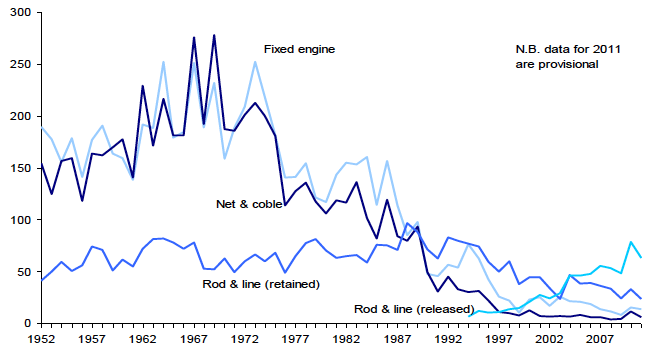Key Scottish Environment Statistics 2012
This publication aims to provide an easily accessible reference document which offers information on a wide range of environmental topics. It covers key datasets on the state of the environment in Scotland, with an emphasis on the trends over time wherever possible.
This document is part of a collection
Catches of Wild Salmon[15]: 1952-2011P
Number caught (thousands)[16],[17],[19]

The salmon fishing industry is a significant economic and leisure resource in rural Scotland. To protect this resource sustainable management practices are essential. Climate change, water pollution, predation and disease may affect populations. Yearly variations in weather, timing of runs and fishing effort can affect catch sizes. Consequently, a difference in catch does not necessarily indicate a difference in the abundance of the stock that provides the catch.
Catch sizes for the fixed engine and net & coble fisheries have fallen by over 90% since 1952. Catches rose during the 1950s and 1960s but have declined rapidly since the early 1970s. The provisional data published for 2011 indicate that 13,802 wild salmon were reported caught and retained in the fixed engine fishery; a slight decline since the rise to 15,577 in 2010 from 8,206 in 2009. The net and coble fishery saw a rise in the number of salmon caught and retained in 2010 to 11,738. 2011 provisional figures indicate this has fallen back in line with recent years to a level of 5,961.[18]
Since 1994, salmon that have been caught and released by anglers have been reported separately. There has been a long-term reduction in the number of salmon caught and retained by the rod & line fishery, however 2010 saw an increase of 36% from the 2009 level to 32,890. Provisional data for 2011 indicates this to have fallen to a similar level found in 2009 of around 24,000. The number of salmon caught and released increased from 6,595 in 1994 to a peak of 78,304 in 2010, but has since fallen in 2011 to 62,953.
The Salmon and Freshwater Fisheries (Consolidation) (Scotland) Act 2003 contains provisions for the conservation and sustainable management of salmon fisheries in Scotland, for example, through regulating the introduction of salmon and salmon eggs into salmon fishery districts for which there is a district salmon fishery board, and regulating the permissible methods and times during which fishing is permitted.
Source: Marine Scotland Science / Metadata
Contact
Email: Sandy McPhee
There is a problem
Thanks for your feedback